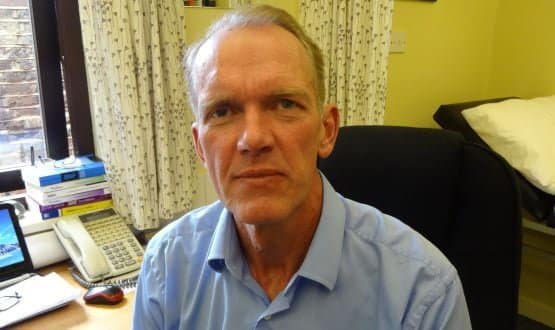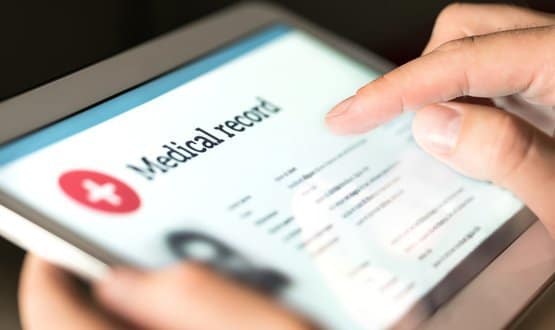EHI interview: Paul Cundy
- 2 October 2014

As Paul Cundy painstakingly digs a splinter out of his finger in the office of his Wimbledon practice, it’s easy to see how much he values attention to detail.
Indeed, Cundy says he was first drawn to IT and computer systems by the “order and precision” that they can provide. “I like the order that IT brings: the computer carries instructions, and as long as the instructions are right, they’re 100% reliable and a perfect mechanism for delivery.”
I want to be a pilot – or a doctor
Dr Cundy’s exposure to the power of programming started at his secondary school, which had a connection to an IBM mainframe to allow students to write programmes. “We sat behind ticker tape machines writing programmes to land lunar machines; and I wrote one to play bridge,” he recalls.
Dr Cundy’s interest in medicine was somewhat more serendipitous. Once, he wanted to be an airline pilot.
“To be honest I stumbled into it really,” he says. “Initially, I wanted to be a pilot, but then I realised that would become somewhat mundane after a while, and so I applied to medical school.
“I received five rejections the first time around. I thought, ‘Blow this, I’ll try again’, and I got another five rejections the second time around. It was almost annoyance at not getting in that made me persevere.”
After completing his training and joining the Wimbledon practice as a GP in 1988, Cundy says it quickly became apparent how his passion for IT could fit into his new career.
“I had to look through the old Lloyd George envelopes [the brown envelopes full of records and notes that traditionally constitute medical records], and it was immediately apparent that it was very difficult to find out information about a patient from their past.
“You had to read every single chart and draw a graph or put the information onto a spreadsheet – I realised that the sooner we got data on patients recorded electronically, the sooner we could manipulate it.”
One of his first tasks was to computerise the practice using the AAH Meditel System 5 – a more complex system than others had wanted, but one that he felt was the best way to make use of the available technology.
The practice is now “paperless”, with all staff referring to fully computerised medical records, clinical correspondence, requesting and results, appointments, patient recall and reviews and performance assessment.
Dr Cundy says the level of computerisation at practices shows “the case has been made” for the merits of electronic records, with the main concern now being to convince the digital stragglers.
“The frustration, I think, is taking the troops with you. There are always people at the tail end of change, and you have to accept that if you implement a new system, you need a three-to-five-year timeframe.”
GPs still well ahead on tech
As long ago as1999, Dr Cundy proposed and developed a policy to legitimise the use of electronic records, by outlining best practice and professional guidelines.
These remain the only professional guidelines related to electronic records to be mandated in law for any profession.
Dr Cundy is surprised other areas of the NHS have not followed the GPs’ lead, although he suspects the way that general practice is set up, with GPs working as partners in a practice, has a lot to do with this.
“We provide our own tools for looking after patients, and from our point of view it’s easier to look after them with IT systems,” he says. “In secondary care, they simply use the system that’s made available to them by their employer.
“If a trust wants to employ someone to push a trolley in with the paper records and then push them out again, the employee doctor will accept that. They have no control over whether they do that or not.”
All of the major GP systems, including those delivered by the two giants in the market, Emis and TPP, were originally designed by GPs and have had “30 years of development and refinement.”
Their strength can be seen in the large number of community and mental health trusts currently choosing Emis Web and SystmOne to replace what Dr Cundy describes as the “laughably basic” systems they were given under the National Programme for IT.
“For heaven’s sake, let’s not go through that again [the National Programme],” he adds hastily. “If you wanted an example of failure and incompetence, that’s it. If they had listened to GPs, they probably would have been further down the road than they are now.”
Good and bad IT in the new GP contract
The present government came into power announcing that it would “scrap” NPfIT, and its approach has been steadily replaced by one that focuses on maintaining national infrastructure and programmes, while leaving trusts to make decisions about IT investments.
Some additional guidance has been provided on standards and on priorities, via two rounds of tech fund bidding. Meanwhile, the GP Systems of Choice contract has been renegotiated, with a focus on getting the existing suppliers to open up their application programming interfaces, and on sharing information across healthcare communities.
None of this gets newspapers writing headlines, though. Which may be why the politicians meeting at their political conferences like to talk about consumer tech and big ideas; extending GP opening hours by offering email and Skype consultations; giving patients access to their records; embracing ‘big data’ through the care.data programme.
Dr Cundy is keener on some of these ideas than others. He points out that the latest version of the GP contract encourages – and rewards – GPs for “promoting and offering a facility” for patients to book appointments and pick up repeat prescriptions online.
He’s less convinced about patient access to records, arguing in a recent comment on the EHI Primary Care website that patients may not understand a professional tool – “the record I use to care for them” – and that this will generate additional work for already overworked practices.
Care.data and other big ideas
Dr Cundy is more exercised, though, about the care.data programme, which wants to expand the Hospital Episode Statistics, link them to other datasets, starting with GP data, and then make them available to researchers and others.
The programme ran into a huge storm of protest in the spring, after NHS England sent out an information leaflet to households that failed to mention it by name or to include an opt-out leaflet.
Four clinical commissioning groups are supposed to restart the programme through pilots shortly. While Dr Cundy recognises the privacy concerns, he says care.data’s really suffers from “ambition over evidence”.
“The fundamental issue is that there is a gap between the ambitions, or aspirations, and the evidence. A lot of people say, ‘If we had access to the data, we would be able to do this and this’, but the evidence isn’t there.”
He also believes that the way that GPs record their data is also unlikely to support the level of analysis and research being suggested.
“A lot of GP data is precisely and accurately recorded but not necessarily linked to diagnostic categories – you can’t necessarily look at all the data and identify everyone with heart disease. I’m not convinced that what is promised to us of open data is really what we can get.”
Dr Cundy raises similar concerns about the current enthusiasm for deploying IT to address the NHS’ financial and quality problems.
He is particularly sceptical of claims that greater use of IT can reduce costs, pointing out the “massive amount of kit and support and hardware that you need to invest in.”
“The real case for IT is that it enables you to have more efficient planning and make better decisions around patient care,” he says.
A good thing, but not one that will magically deliver on the ‘Nicholson Challenge’ to find £30 billion of efficiency savings to plug the gap between funding and demand that is threatening to open up – even if the Tories and Labour deliver on their pledges to “maintain” NHS spending or create a “Time to Care” fund.
Dr Cundy would also like “a much more evidence-based approach” to care and IT; particularly when the evidence suggests that something shouldn’t be pursued. “Telecare is a brilliant example: except for some very niche areas, we know it does not work.”
The really big issue: the future of general practice
Dr Cundy has been speaking out on IT issues since he was first elected to sit on the GPC’s IT committee in 1995, becoming vice-chair the following year. In 1998, he started a ten-year chairmanship of the committee, with a two-year gap from 2008 to 2010 until he resumed the role.
Cundy says the main issues he is working on at present are “evolving” the national GP contract, advocating for choice of IT system GPs, and increased interoperability, with a particular focus on clinical communication.
GP2GP record transfers are also a point of focus, with the requirement for practices to be able to transfer records using the system by April 2015 – a decision that Cundy says GPs fully support.
“If you register in my surgery and I take my blood pressure and record it on my system, then you go and register in Oxford, at the moment there’s no way that blood pressure can be transferred to Oxford. With GP2GP, the records will be inserted into GP’s system as if I had entered it myself.”
However, as Labour promises that everyone will be able to see a GP within 48 hours, and the Tories trump that with a named GP for every patient and 12 hour a day, seven day a week working, his biggest concern is the threat of closure under which many GP practices are operating.
“I think general practice is on a cliff edge, and in this sense the IT will follow where general practice goes. It’s quite possible the traditional GP may go and what we may see is an employee-led service.
“If we end up with that sort of service, their grasp or desire to continue to mould systems will reduce, and if we move to larger groupings then we may well see that individual fine-tuning of systems disappear.”




